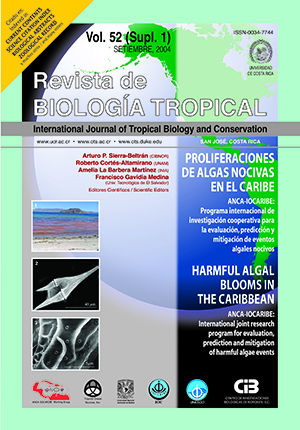Abstract
Recently, the Pacific coast of Costa Rica has experienced an increase in both magnitude and frequency of harmful algae blooms (HAB). The lack of data regarding the dynamics of these events in the area, and the species of microalgae that produce them, are themes of great interest. The blooms have produced negative impacts on fishery resources and on human health in Costa Rica. In May 2002 a HAB left a large number of dead fish along the central Pacific coast. Water samples were collected using a phytoplankton net and fixed for subsequent processing by electron microscopy. In addition, a one liter sample of surface water was taken for later cell count. In the observed HAB, the dominating organisms found were the cyanobacteria Trichodesmiun erythraeum surrounded by high concentrations of Gram - bacteria and the dinoflagellate Cochlodinium cf. polykrikoides. T. erythraeum, is one of the most important N2 fixing cyanobacteria in marine waters that has been associated with HAB events in diverse parts of the world as well as with symptoms that produce contact dermatitis and other discomforts. C. cf. polykrikoides is a dinoflagellete associated with fish kills; although the type of associated toxins are unknown. In a national newspaper 17 cases of intoxication in humans were reported during this same period, which presented respiratory disorders and burning of the eyes. This is the first report in Costa Rica where a cyanobacteria and a dinoflagellate were observed together producing HAB.References
Anderson, D.M., P. Andersen, V.M. Bricelj, J.J. Cullen & J.E. Rensel. 2001. Monitoring and Management Strategies for Harmful Algae Blooms in Coastal Waters, APEC #201-MR-01.1, Asia Pacific Economic Program, Singapore, and Intergovernmental Oceanographic Commission Technical Series No. 59, Paris. 230 p.
Capone, D., A. Subramanian, J. Montoya, M. Voss, C. Humborg, A. Johansen, R. Siefert & E. Carpenter. 1998. An extensive bloom of the N2-fixing cyanobaterium Trichodesmiun erythraeum in the central Arabian Sea. Phycologia 26: 189-194.
Fukuyo, Y., H. Takano, M. Chihara & K. Matsuoka. 1990. Red tide organisms in Japan: An illustrate taxonomic guide. Uchida Rokakuho, Tokyo, Japan. 430 p.
Karnovsky, M.J. 1965. A formaldehyde-glutaraldehyde fixative of high osmolarity for use in electron microscopy. J. Cell. Biol. 27: 137A.
Landsberg, J. 2002. The Effects of Harmful Algae Blooms on Aquatic Organisms. Rev. Fish. Sci. 10 (2): 1-412.
Hallegraeff, G.M. 2002. Aquaculturists` Guide to Harmful Australian Microalgae. School of Plant Science, University of Tasmania, Hobart, Tasmania, Australia. 136 p.
Paerl, H.W., Bebout B.M. & L.E. Prufert. 1989. Bacterial associations with marine Oscillatoria sp. (Trichodesmium sp.) populations: ecophysiological implications. J. Phycol. 25: 773-784.
Sar, E.A., M.E. Ferrario & B. Reguera. 2002. Floraciones Algales Nocivas en el Cono Sur Americano. Instituto Español de Oceanografía, Intergovernmental Oceanographic Commission of UNESCO. 311 p.
Smayda, T. 2002. Turbulence, watermass stratification and harmful algal blooms: an alternative view and frontal zones as “pelagic seed banks”. Harmful Algae Vol. 1, pp. 95-112.
Siddiqui, P.J., B. Bergman & E.J. Carpenter. 1992. Filamentous cyanobacterial associates of the marine planktonic cyanobacterium Trichodesmium, Phycologia 31: 326-337.
Sook Kim, C., S. Geun Lee & H. Gyoon Kim. 2001. Icthyotoxocity of a Harmful Dinoflagellate Cochlodinium polykrikoides. Second International Conference on Harmful Algae Management and Mitigation. Intergovernmental Oceanographic Commission of UNESCO. 247 p.
Suvapepant, S. & T. Lertvidhayaprasit. 1995. Red-tides and red-tides research in Thailand waters. Dept. of Fisheries, Bangkok. pp. 1-11.
Whyte, J.N.C., N. Haigh, N. Ginther & L. Keddy. 2001. Phytoplankton Killers of Pen-Reared Salmon in British Columbia.Second International Conference on Harmful Algae Management and Mitigation. Intergovernmental Oceanographic Commission of UNESCO. 247 p.
##plugins.facebook.comentarios##

This work is licensed under a Creative Commons Attribution 4.0 International License.
Copyright (c) 2004 Revista de Biología Tropical


